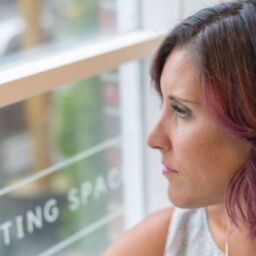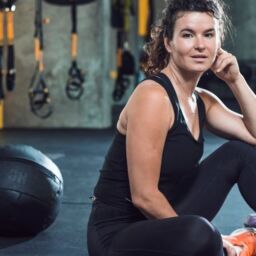
About the Podcast:
Cognitive flexibility has a big impact on your emotional health and wellness. In a nutshell, cognitive flexibility is the ability to appropriately switch your thinking and your actions. It may not sound exciting or glamorous, but it directly impacts your creativity, resilience, and quality of life. The more cognitively flexible you are, the better able you are to respond to changes in your environment. So if you want to be more cognitively flexible, what can you do?
In this episode you’ll learn how using The Model can help you decrease cognitive rigidity and increase cognitive flexibility. Listen in to hear ideas, examples, and questions that will help you stretch your thinking and challenge unhelpful beliefs.
What You’ll Learn:
- What cognitive flexibility is and why you want more of it
- How differentiating circumstances from thoughts can increase cognitive flexibility
- Why truth and facts are not synonymous
- 3 things that impact our understanding of truth
- 10 questions you can use to challenge unhelpful beliefs and increase cognitive flexibility
- Why our brains default to simplistic, black-and-white thinking that limits cognitive flexibility
Featured in the Episode:
- Cognitive flexibility articles – ScienceDirect, NIH, and BetterUp
- Dieter F. Uchtdorf General Conference Talk, October 2013
- FREE “Feel More Confident” Cheat Sheet
- Connect with me on Instagram and Facebook
Does any of this sound familiar?
- You’re a smart, accomplished woman with advanced degrees and certifications.
- You’re detail-oriented, and you pride yourself on doing quality work.
- You have years of experience and think you should feel confident in what you do.
Despite all of that:
- You feel insecure speaking up in meetings and presenting to others.
- You hold back sharing ideas or asking questions in meetings because you’re worried what others will think of you.
- You obsess over details and worry about getting everything “just right.”
- You find yourself constantly reviewing and tweaking your work to make it a little better.
- You feel anxious and stuck when you can’t get something “just right” or when you’re not sure what “just right” is.
If that sounds like you, I want you to know you’re not alone.
If you’d like to feel more confident in your career and personal life, my FREE “Feel More Confident” cheat sheet can help. You’ll learn 3 simple steps to start feeling more confident today.
If you’d like even more help, sign up for a FREE confidence booster call with me. We’ll meet on Zoom, and in just 45 minutes, I’ll identify one of YOUR confidence blockers (it’s not the same for everyone), and I’ll tell you one thing you can do to fix it. Then, if you’re interested, I’ll share information about my one-on-one confidence coaching program. Whether you sign up or not, you’ll leave the call knowing one thing you can do to feel more confident.
Confidence doesn’t come from degrees, certifications, accolades or experience. It’s a learnable skill, and I can teach you how to have it for the rest of your life.
Schedule a free confidence booster call to get started today.
Full Episode Transcript:
Welcome to the Perfectionist Professional Woman podcast. This is episode 14, “Truth, Facts, and Cognitive Flexibility.”
I’m Keri Martinez. I’m a wife and mother of three children and three bonus children. I’m also a certified life coach and a member of the Church of Jesus Christ of Latter-day Saints. For a good portion of my life, I equated perfection with happiness and success. I thought that striving to be perfect and do things perfectly was the key to feeling happy and to being successful. I’ve since come to realize that perfection isn’t necessary to achieve either one of those–quite the opposite, in fact–and that has made such a difference in how I think, feel, and experience life. So if you’re a professional woman and you’d like to know how to release perfectionism so you can trade self-doubt for self-confidence, stop beating yourself up, and start enjoying your life more, then come with me. Let’s do this together.
Hello! If you’re new to the podcast, welcome and thanks for listening today. If you’ve been here before, welcome back! I’m honored and amazed and grateful that you’re choosing to spend a few minutes with me, so thanks for tuning in.
In this episode I want to go a little deeper into some things I touched on last week, which are truth and facts, and I want to talk about those in relation to a concept from psychology called cognitive flexibility. In saying that, I realize it might sound a little abstract and kind of dry for a podcast topic, so let me explain why it’s actually not, why this episode is worth your time and attention.
Let me start with cognitive flexibility. Cognitive flexibility refers to the ability to switch your thinking and your actions. It can be switching between thinking about different concepts, like going from one point of view to another, or it can be switching between tasks or behaviors, like going from typing an email to preparing a presentation outline. The more cognitively flexible you are, the better you are able to respond to and handle changes in your environment. Cognitive flexibility is associated with higher levels of creativity, resilience, quality of life, and even reading ability, so having cognitive flexibility is a good thing. It’s a great thing! And it’s more useful and helpful than its opposite, which is cognitive rigidity.
One article I read on the BetterUp website compared the difference between cognitive flexibility and rigidity to the difference between water and ice. Water is able to flow in different patterns and directions. It can adjust its course to flow around rocks and other obstacles it encounters. Ice, on the other hand, isn’t able to do that. When ice encounters an obstacle, it butts up against it and stops. So if you have cognitive flexibility, you’re more able to find options to flow around obstacles you encounter. If you’re cognitively rigid, however, you’ll encounter obstacles and remain stuck.
So we want to be cognitively flexible, and doing things to increase our cognitive flexibility will enhance our ability to solve problems, it will increase our creativity and resilience, and all of that will enhance our overall quality of life. And one of the ways we can increase our cognitive flexibility is to use The Model, which is the tool I talked about last week.
So let’s talk about how you can use The Model to help increase your cognitive flexibility. If you recall, there are five lines or sections of The Model, and those are circumstances, thoughts, feelings, actions, and results. I’m going to focus today on just the first two lines – circumstances and thoughts.
If you recall, circumstances are things that are factual. They’re not up for debate or interpretation, they could be proven in a court of law, and everyone on earth would agree on them. Circumstances are things like the current temperature, the exact words someone said, a person’s height or weight, the amount of money in someone’s bank account, and the current price of a particular stock.
Thoughts are not factual. They can’t be proven in a court of law, they are subjective and up for debate or interpretation, and not everyone would agree on them. Thoughts are simply sentences in our brain; they’re sentences our brain made up. Thoughts include statements like, “It’s hot outside,” “Working full-time and raising children is hard,” “I have too much to do,” “She’s nice,” “I’m a failure,” and “Chocolate is amazing.”
Circumstances are facts or factual, thoughts are not. Now, does that mean only circumstances can be true? Does that mean thoughts can’t be or are not true?
And I want to play with this idea of truth for a minute. We tend to equate truth with facts, right? We often consider truth and facts to be synonymous. So if something isn’t factual, we might infer it’s not true. But I don’t think that’s the case, at least not all the time, and I want to push back on that idea a little bit. I think both circumstances and thoughts can be “true” even though thoughts aren’t factual.
So let’s think about what we mean when we say something is true. As a child, I understood truth to be something absolute and universal. It was very black and white, very concrete. Something was either true or not, like a lightswitch being on or off. I learned the difference between truth and lies and that I shouldn’t lie. To my young brain, anything that wasn’t true was a lie, and if I knew something to be true and you didn’t agree, you must be wrong or lying. Those were the only two options for me. And that kind of thinking isn’t unusual in children – children’s brains are normally very concrete and egocentric like that.
When I was younger, I also understood truth to be something consistent, unchanging, even eternal. If something were really true, it would be true forever, regardless of if someone believed it or not. Like gravity – you can say you don’t believe in it, but if you walk off the edge of a cliff, the truth of gravity is still going to cause you to plummet to the earth.
As I got older, my understanding of truth began to change. I started to notice that truth could be subjective and conditional due to things like situational blindness. If you’re familiar with the Indian fable “The Blind Men and the Elephant,” you know something about this. In the story, six blind men attempt to learn what an elephant is by touching one. One man feels the elephant’s leg and says the elephant is like a tree. Another feels the trunk and says the elephant is like a snake. Another feels the tusk and says the elephant is like a spear. Another feels an ear and says the elephant is like a fan. Another feels the side of the elephant and says it’s a wall. The last man feels the tail and says it’s like a rope. Each man gives a “true” account of the elephant, but none has a complete picture. And sometimes it’s like that for us when we’re not able to see all aspects of a particular situation.
I remember when I transitioned from a classroom teacher into a more of an administrative role, my perspective on supply budgets, state testing schedules, and a number of other things changed quite a bit. As a classroom teacher, I wasn’t able to see those things through a school-wide lens. My eyes were opened a lot, though, once I left the classroom and started working with the entire staff. Another similar shift happened when I transitioned from the school site to the district office. I saw things from a much broader perspective when I began working with staff from many schools and district departments. And all of a sudden certain district policies made sense that had been baffling and even irritating before. So often we don’t know what we don’t know, and that affects what is true for us.
There’s a quote I really like from Dieter F. Uchtdorf that relates well to this. He said, “Sometimes questions arise because we simply don’t have all the information and we just need a bit more patience. When the entire truth is eventually known, things that didn’t make sense to us before will be resolved to our satisfaction.” Now he said that in a religious context, but I’ve found it to be true in pretty much every area of life.
Sometimes what is true for us changes as part of our evolution, growth, and learning. For example, for hundreds of years, humans “knew” the Earth was flat and that the Sun revolved around it. We now know the Earth is mostly spherical and it revolves around the Sun. Similarly, it used to be true that space travel and instant communication with someone hundreds of miles away weren’t possible. Now it’s true that both of those are possible.
Lastly, our understanding of what is true is also impacted by our life experiences. A child that grows up in a loving, nurturing home will have a very different understanding of what’s true about families from one that grows up in an abusive home. What’s true about personal safety will be very different for someone who’s been bullied or physically attacked than it will be for someone who hasn’t had those experiences. What’s true about risk taking will be different for someone who’s been punished for failing than it will be for someone who was encouraged to fail to learn.
So people perceive truth differently for different reasons. And that’s not a problem…at least it doesn’t have to be. And this idea gets to the heart of cognitive flexibility. Being able to see things from different perspectives, being able to consider that two seemingly opposing ideas can both be true, being able to look for truth beyond what you know, can be very useful and liberating.
I talked a lot in last week’s episode about differentiating circumstances from thoughts, differentiating facts from the stories our brains make up about those facts, and I said we can create problems for ourselves when we have thoughts we think are circumstances. We have thoughts and believe they’re factual because we’ve been thinking them for so long or we’ve never thought to question them. We just assume they’re the truth of the world. When we do that – when we believe thoughts are circumstances – we limit our ability to be cognitively flexible. If we think a thought is a circumstance, if we think a thought is factual, we lose our ability to see other options. If I think it’s a fact that parenting is hard or my boss is a jerk or I can’t lose weight or I don’t know how to run my own business, I slam the door on my brain seeing other alternatives. I shut down the part of my brain that’s able to consider that other things might be true. I’m then cognitively rigid and stuck. If it’s a fact that parenting is hard, I can’t do anything to change that. If it’s a fact that my boss is a jerk, I either have to live with that or get a different boss. If it’s a fact that I’m not able to lose weight, I can only either stay at my current weight or gain weight. If it’s a fact that I don’t know how to run my own business, I’ll never be able to figure it out. In all of those situations, I’ll be stuck with no other options, and that’s a terrible place to be.
Here’s one more example. Let’s say I think it’s a fact that husbands and wives should share a bank account but my husband thinks husbands and wives should each have their own accounts. If I’m convinced of the factualness of my thought, the only way for me to resolve the difference is to convince my husband I’m right or go against my beliefs and give in to something that I “know” to be wrong. I’m again stuck with no other options.
So now let’s go back to the question of how we use The Model to help us increase our cognitive flexibility so we can see other options and get unstuck.
The first and most important thing we can do is differentiate between circumstances and our thoughts about them, and we can do that by asking, “Would everyone in the world agree with this?” or “Can this be proven in a court of law?” If you think something is true but someone else disagrees, like my previous bank account example, that’s a dead giveaway it’s a thought and not a circumstance. Husbands and wives can have joint or separate accounts – that is factual. It could be proven in a court of law. Everyone would agree. That’s a circumstance. Not everyone would agree that husbands and wives should have joint accounts, so that’s not a fact, that’s not a circumstance. It’s a thought.
You can also look for words like “should,” “always,” “never,” and any adjectives. If adjectives or “should,” “always” or “never” are included in a statement, it’s almost certainly a thought and not a circumstance. For example, the HR manager said, “You need to arrive at work on time each day.” That is factual and could be proven in a court of law. That’s a circumstance. Good employees always arrive on time to work – that’s not a circumstance because not everyone would agree that arriving on time is something good employees always do.
When you determine something is a thought, the next thing you can do is consider if the thought is serving you or not. Is it helpful or not? Take your focus away from the “truthfulness” of the thought and ask yourself, “Even if it’s true, is this thought helping me?” For example, “Even if it’s true that I’ve never applied for a position like that, is that thought helping me?” “Even if it’s true that I’ve never given a presentation without being nervous, is that thought serving me?” “Even if it’s true that my mother-in-law doesn’t like me, is it useful for me to think that?”
Ask yourself questions about your thoughts to stretch your thinking, to enable you to see other options. This is particularly helpful for thoughts that aren’t serving you, but it will increase your cognitive flexibility to do this with pretty much any thought. So ask yourself questions like:
- Is that really true? If so, how do I know?
- What else might be true?
- How else could I think about this?
- How might someone else (like Oprah or your best friend or a mentor) think differently about this?
- How could this be happening for me?
- How is this perfect or helpful for me?
- What are my options here?
- How is the opposite also true?
- What if I did know?
So let’s look at some examples. Let’s say you’re thinking, “I’m never going to get promoted.” To expand your cognitive flexibility, you could ask yourself, “Is that really true? How do I know it’s really true? Does that mean I’ll never get promoted? What else might be true? How could being passed over for the promotion before be helpful for me?”
Next example. If you’re thinking, “It’s too hard to work full time and be a mom to young kids” you could ask yourself, “What about this is actually easy? How is working full time with kids easier than working full time without kids? Or how is working full time with kids easier than working part time with kids? How else could I think about this? How might my best friend or Jennifer Garner or even Beyoncé think about this?”
Last example. If you’re thinking, “I don’t know how we’re going to get this project done on time,” you could ask yourself, “What if I did know how we could get this done on time? How might Oprah or my mentor think about this? What are our options here?”
So I hope you can see that in each of those examples, the point wasn’t to convince yourself that your thought was wrong or that you needed to change it. You never need to change what you’re thinking if you don’t want to, because you have agency over your thoughts. If you recognize a thought isn’t serving you, though, you might want to change it, and asking yourself those kinds of questions can help you do that by helping you expand your perspective and see what else is possible.
The last thing I want to talk about is increasing your cognitive flexibility when you’re thinking or believing something and someone else is thinking or believing something different. I gave an example earlier about husbands and wives sharing or having separate bank accounts. If I’m convinced of the factuality of my belief, the only way to resolve the difference is to convince my husband I’m right or abandon my truth and go with something I believe to be wrong. But what if we’re both right? What if what I think is true and right for me and what he thinks is true and right for him? Being cognitively flexible in this situation is allowing for and accepting both truths, both viewpoints.
Our brains are always trying to conserve energy, so their default is always to simplify situations with “this-or-that” type thinking. Like I’m right, so you’re wrong, or vice versa. It’s one way or another. Our brains are not so good at recognizing two seemingly opposing ideas could both be true. But if we take a minute to look beyond our brain’s default this-or-that thinking, it’s easier for us to see that one viewpoint isn’t correct at the expense of the other. Sometimes both can be true.
This, again, is not to say that you need to change your mind about what you think is true. But can you allow that something different might be true for someone else? Cognitive flexibility allows you to recognize that you don’t need to make someone else’s beliefs wrong for your beliefs to be right. You can let go of the burden of trying to convince the other person to think and believe as you do and you can simply accept them and their beliefs as they are. It is a beautiful, peaceful way to live.
My husband and I have similar beliefs and preferences in a lot of areas, but we definitely don’t align on everything. And in the early years of our marriage, I remember worrying and feeling anxious when we didn’t see eye-to-eye on things. I would then either try to convince him my views were correct or more than likely most of the time I made some passive aggressive comment about his views being wrong. Well, one of the things I’ve always admired about my husband is that he stands up for what he believes. He’s not afraid to challenge others if he thinks they’re wrong, and he doesn’t cave to peer pressure. So, you can imagine how successful I was when I tried to convince him he was wrong. Yeah, it didn’t usually turn out like I wanted. Anyway, years later, I was being coached on one of those kinds of situations. I remember I was upset and worried about our marriage because we weren’t “being one” as the scriptures say man and wife should be. My coach then asked me if “being one” meant we had to agree all the time, that we had to have the same opinion on everything. And a big lightbulb went off in my head at that moment. I realized of course we don’t need to have the same opinions about everything! Of course we don’t need to agree all the time! We can absolutely have different opinions and still have a healthy, successful marriage. So ever since then, when we have differences of opinion, it’s much easier for me to accept it and not make it a problem. I just remind myself it’s possible we’re both right and it’s okay to see the world differently. It’s actually a beautiful thing that we do.
OK. One more story. This one is work-related. Throughout my years working at the district office, I helped train teachers and administrators on a variety of programs and systems. My school district was fairly large – it had more than 50,000 students and more than 2,000 teachers and administrators – so anytime we did district-wide training, it involved hundreds up to thousands of staff. Sometimes we’d train people at their school sites, sometimes we’d train them at the district office, and when COVID hit, we started training completely online.
It didn’t matter what we were training on, where or when we did the training, what refreshments we served, which icebreakers we used, whether we did sit-and-get or hands-on style, there were always people that loved the training and some that hated it. There were those excited to use the programs and those that thought the programs were a waste of money and time. There were those who wanted to collaborate and learn more and those who couldn’t wait to leave anytime we had a break. The majority of people were in the first camp, but there were at least a few that disagreed with or weren’t happy about what we were doing.
When preparing for a training, my team and I would look for ways the various staff could use the programs to be more efficient and effective in their roles, and then we’d incorporate that in the training. We’d share the value and benefits we saw in the tools and how we would use them if we were in their shoes. There were some things we didn’t care for in each program, and some things drove us a little nuts, but no program is perfect and we tended to think the benefits outweighed the drawbacks of each one. When people didn’t share our view, I’d feel anxious and try to convince them to see it my way. It rarely worked, and in fact many times I’d interpret their rejection of a particular program as a rejection of me, and that was pretty painful. At the time, I didn’t realize that’s what I was doing. After I started getting coached, though, I realized it was okay for others not to feel the same way about these programs, and their different opinion had nothing to do with me and my personal worth. It was okay they didn’t like the program and didn’t want to use it. I could teach them about the program. I could talk to them about their needs and share how the program could help with those. I could tell them how I thought the program would help them do their job faster and better, but in the end, the choice was up to them. I realized I didn’t need to carry the burden of trying to convince everyone to see things my way, and let me tell you, recognizing that and finally releasing that burden was such a relief!
All right, I hope you found all of that helpful and that you can see the benefit of increasing your cognitive flexibility. Using The Model and getting coached has really helped me increase my cognitive flexibility, and that’s made such a difference in how I experience life. I’m much more calm, I don’t freak out when other people are upset or have different opinions from me, I’m less nervous talking to other people because I’m better able to see different perspectives, I don’t get upset as much the little things that happen, and I’m much more confident in my ability to just handle life. It didn’t happen overnight, and I’m continuing to work on it, but I will say the time and energy I have invested has been completely worth it. If you want the same things in your life, I hope you’ll give this a try. And if you want me to guide you through, if you want more help, you need to come work with me. Head to my website at kerimatinez.com/schedule and book a one-on-one session with me so we can talk about how you can do that.
OK. See you next week.
Thanks for listening to this episode of the Perfectionist Professional Woman podcast. To see show notes and a transcript, head over to kerimartinez.com/ podcast. That’s k-e-r-i-m-a-r-t-i-n-e-z dot com forward slash podcast. And while you’re there, click the link to download my free “Feel More Confident” cheat sheet. If you’re a working mother and you’d like to feel more confident in your career and your personal life so you can stop letting fear hold you back, this cheat sheet will help.
Have a beautiful week – ciao for now!















